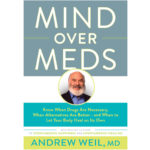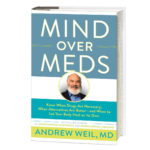Ending The Opioid Epidemic?
I’m horrified by the opioid epidemic that seems to be worsening. A friend with chronic pain – resulting from an injury – appears to be hooked. Are there any less dangerous alternatives?
Andrew Weil, M.D. | May 2, 2017

The ongoing opioid epidemic in the U.S. is frightening. According to the U.S. Centers for Disease Control and Prevention (CDC), more people died from drug overdoses in 2014 (the last year for which we have complete numbers) than in any other year on record. More than 60 percent of those deaths involved an opioid. Since 1999, more than 165,000 people have died from prescription opioid overdoses.
The inappropriate use of opioids – and the integrative alternatives available – is a subject covered in my new book, Mind Over Meds: Know when Drugs are Necessary, When Alternatives are Better—and When to Let Your Body Heal on Its Own. I asked Robert Bonakdar, M.D., director of pain management at the Scripps Center for Integrative Medicine in La Jolla, CA, to address this difficult subject. He makes the point that the incidence of chronic pain syndrome has increased enormously in recent years, provoking much debate about treatment strategies. Dr. Bonakdar notes that one reason for this increase is the number of war veterans returning home with devastating injuries, many of which would have been fatal were it not for recent advances in trauma medicine. He also writes that pain is still the most common reason people see a doctor worldwide. The problem might start as an acute bout of low back, neck, or head pain, but for more than 100 million Americans (and more than 1.5 billion people worldwide) it lasts more than several months, becoming chronic. Chronic pain syndrome is also associated with migraine, arthritis, fibromyalgia, cancer, and neuropathy (nerve pain, a common complication of diabetes and a side effect of some forms of cancer chemotherapy). In addition, chronic pain is often accompanied by fatigue, sleeping problems, depression, anxiety and cognitive impairment.
Opioids are very effective for acute pain, but Dr. Bonakdar points out that many experts now agree that the risks associated with their long-term use are likely to outweigh the benefits for most types of non-cancer pain.
He blames doctors for most of today’s overuse of opioids for pain relief, suggesting that physicians convince themselves and patients that each new version is safer than the last. Another problem: pharmaceutical companies produce vastly more opioid drugs than are needed for legitimate medical use. Much of that production is diverted to the black market. OxyContin is so popular in rural America that it has become known as “hillbilly heroin.”
Fortunately, there are workable alternatives to treating chronic pain with drugs: integrative therapies can help and are increasingly being put into practice. These include acupuncture, massage, manual manipulation, yoga and supervised exercise and physical therapy. Hypnosis can work so well for acute pain that in subjects with a high capacity for trance, it can be used in place of pharmacological anesthesia for dental procedures and even major surgery.
You’ll learn much more about this problem and the available solutions in Chapter 12 of Mind Over Meds. But here’s Dr. Bonakdar’s bottom line: if you or someone close to you suffers from chronic pain syndrome, insist on an integrative treatment plan and recognize that drugs can’t address all the problems chronic pain presents.
Andrew Weil, M.D.
Read an excerpt from Mind Over Meds – “Too Many Meds: The Problem And The Solution“













